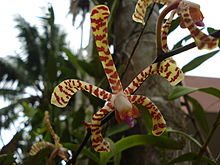Arachnis (orchids)
| Arachnis | ||||||||||||
|---|---|---|---|---|---|---|---|---|---|---|---|---|

Arachnis labrosa , illustration |
||||||||||||
| Systematics | ||||||||||||
|
||||||||||||
| Scientific name | ||||||||||||
| Arachnis | ||||||||||||
| flower |
The plant genus Arachnis belongs to the family of orchids (Orchidaceae). The approximately 15 species grow epiphytically in tropical Asia. The species - especially Arachnis hookeriana - were often used to breed orchid hybrids for cut flower production.
description
Vegetative characteristics
The Arachnis species grow monopodially with occasional branches. The stem axis is often stretched like a liana, in some species the internodes are not as long and the stem axis grows upright or overhanging. The roots are mostly distributed along the stem axis, occasionally only in the lower area.
The leaves are arranged in two rows, long-oval to ribbon-shaped, with a drawn-in tip somewhat bilobed.
Generative characteristics
The racemose or paniculate inflorescences arise laterally from the leaf axils in the upper area of the stem axes and usually protrude above the leaves.
The hermaphrodite flowers are zygomorphic and threefold. The bracts are not fused, spread out and have a fleshy texture. Except for the lip, the bracts are shaped identically - very narrow, obovate or spatulate. The small lip forms a spur at the base and at this point is articulated with the short extension of the column (column base). The blade of the lip is three-lobed, with the small lateral lobes standing upright and the middle lobe being covered with a longitudinal callus. At the end of the short, compact column is the stamen with four pollinia in two pairs.
Locations
They are epiphytically growing plants of ever humid and seasonally dry tropical forests.
Systematics and distribution
The genus Arachnis is part of the subtribe Aeridinae. Crosses with numerous related genera such as Ascocentrum , Phalaenopsis , Renanthera and Vanda were realized.
The genus Arachnis was established in 1825 by Carl Ludwig Blume . The generic name Arachnis is derived from the Greek word arachne for "spider" and refers to the shape of the flower. Synonyms for Arachnis flower are: Esmeralda Rchb. f. , Armodorum Breda , Arachnanthe Blume , Arhynchium Lindl.
The species of the genus Arachnis are common in tropical Asia. In the northwest, the distribution area extends to Bhutan and Sikkim, to the southeast, southern China, rear India , the Philippines and Borneo are populated, the area extends to New Guinea and the Solomon Islands .
There are about 15 Arachnis species:
- Arachnis annamensis (Rolfe) JJSm. (Syn .: Arachnis evrardii (Guillaumin) Tang & FTWang ): It occurs in Cambodia and southern Vietnam .
- Arachnis bella (Rchb. F.) JJSm. : It occurs from Nepal to Yunnan .
- Arachnis bouffordii Ormerod : It wasfirst describedin 2014 from Hainan .
- Arachnis calcarata Holttum : It occurs on Borneo in Sabah and Sarawak .
- Arachnis cathcartii (Lindl.) JJSm. : It occurs from the east-central and east Himalayas to Assam .
- Arachnis flos-aeris (L.) Rchb. f. (Syn .: Arachnis moschifera flower , Arachnis flos-aeris var. Gracilis Holttum ): It occurs in Cambodia , Thailand, western Malesia and the Philippines .
- Arachnis grandisepala J.J.Wood : It wasfirst describedin 1981 from northern Borneo .
- Arachnis hookeriana (Rchb.f.) Rchb. f. (Syn .: Arachnis alba (Ridl.) Schltr. ): It occurs in Malaysia , Vietnam and Borneo.
- Arachnis labrosa (Lindl. & Paxton) Rchb. f. There have been two varieties since 2009:
- Arachnis limax Seidenf. : It occurs in Thailand.
- Arachnis longisepala (JJWood) Shim, Soón & ALLamb : It only occurs in northern Borneo.
- Arachnis senapatiana (Phukan & AAMao) Kocyan & Schuit. : This endemic occurs in Assam only in Manipur .
- Arachnis seramensis (Ormerod) R. Rice : It occurs on the Moluccan island of Seram .
- Arachnis siamensis (Schltr.) Tang & FTWang : It occurs in Thailand, Myanmar and Vietnam.
- Arachnis sulingi (flower) Rchb.f. : It occurs from Sumatra to Bali .
The nature hybrid of Arachnis flos-aeris × Arachnis hookeriana becomes Arachnis × maingayi (Hook. F.) Schltr. called.
No longer to be included in the genus Arachnis :
- Arachnis beccarii Rchb. f. → Dimorphorchis beccarii (Rchb. F.) Kocyan & Schuit.
- Arachnis breviscapa (YYSm.) YYSm. → Dimorphorchis breviscapa (JJSm.) Kocyan & Schuit.
- Arachnis celebica (Schltr.) JJSm. → Dimorphorchis breviscapa (JJSm.) Kocyan & Schuit.
- Arachnis longicaulis (Schltr.) LOWilliams → Dimorphorchis breviscapa (JJSm.) Kocyan & Schuit.
literature
Most of the information in this article comes from:
- Jim B. Comber: Orchids of Java . Bentham-Moxon Trust, Kew 1990, ISBN 0-947643-21-4 , pp. 324-325 .
- Xinqi Chen & Jeffrey J. Wood: Arachnis , p. 465 - online with the same text as the printed work , In: Wu Zheng-yi, Peter H. Raven, Deyuan Hong (ed.): Flora of China. Volume 25: Orchidaceae. Science Press and Missouri Botanical Garden Press, Beijing and St. Louis, 2009, ISBN 978-1-930723-90-0 .
Individual evidence
- ↑ Helmut Genaust: Etymological dictionary of botanical plant names. 3rd, completely revised and expanded edition. Nikol, Hamburg 2005, ISBN 3-937872-16-7 (reprint from 1996).
- ↑ a b c d e f g h i j k l m n o p q r s t Rafaël Govaerts (Ed.): Arachnis. In: World Checklist of Selected Plant Families (WCSP) - The Board of Trustees of the Royal Botanic Gardens, Kew . Retrieved April 5, 2020.


